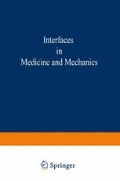Summary
The risk of fatigue fractures of the femoral stem in a cemented total hip arthroplasty can be minimized by either incrinsing the stem cross section and/or using very high strength alloys. The aim of this experiment was to evaluate important mechanical characteristics of five selected stems, differing in design and material (stainless steel, chrome cobalt alloy, nickel based alloy, titanium alloy and carbon-carbon composite). Strain gages were glued on the lateral and medial aspects of each stem. After cementing into cadaver femurs, each stem was loaded up to 3000 N in a tension-compression machine and the stress patterns were recorded. Regardless of stem type, the typical stress distribution was a bell shaped curve. For cobalt chrome alloy and stainless steel stems, the larger stems resulted in lower stresses and higher factors of safety. The factor of safety was increased even further when using super alloys such as MP35N and Ti6A14V. Low modulus materials i.e. carbon-carbon composites exhibited lower stresses resulting in a safety factor close to MP35N. In addition, low modulus materials allowed the use of larger and stronger stems without the extra penalty of a high rigidity which was enforced by either the steel or cobalt based alloys.
Access this chapter
Tax calculation will be finalised at checkout
Purchases are for personal use only
Preview
Unable to display preview. Download preview PDF.
References
-Bartel D.L., Desormeaux S.G., Femoral stem performance. In: Proc. Symp. Retrieval and analysis of orthopaedic implants. (Ed. by Weinstein E., Horswitz E., Ruff A.W.), Dept. of Commerce, National Bureau of Standard, Special pubication, 1973.
-Chao E.Y.S., Coventry M.B. Fracture of femoral component after total hip replacement. An analysis of 58 cases. J. Bone Jt. Surg., 1981, 63A, p.1078–1094.
-Crowinshield R.D., Brand R.A., Johnston R.C., Milroy J.C. An analysis of femoral component stem design in total hip arthroplasty. J. Bone Jt. Surg., 1980, 62A, p.68–78.
-Dobbs H.S. The fracture of femoral components-an act of God? Eng. in Med., 1980, 8, p.237–240.
-Ducheyne P., De Meester P., Aernoudt E., Martens M., Mulier J. Fatigue fractures of the femoral component of Charnley and Charnley Muller type total hip prostheses. J. Biomed. Mater. Res. Symp., 1975, 6, p.199–219.
-Martens M., Aernoudt E., De Meester P., Ducheyne P., Mulier J., Delangh R., Kesterlijn P. Factors in the mechanical failure of the femoral component in total hip prostheses. Acta Orthop. Scand., 1974, 45, p.693–710.
-Miller E.H., Shastri R., Shih C.I. Fracture failure of a forged vitallium prosthesis. J. Bone Jt. Surg., 1982, 64A, p.1359–1363.
-Charnley J., Fracture of femoral prostheses in total hip replacements -a clinical study. Clin. Orthop. 111, 1974, p.105–120.
-Crowinshield R.D., Brand R.A., Johnston R.C., Pedersen P.R. An analysis of collar function and the use of titanium in femoral prostheses. Clin. Orthop., 1981, 158, p.260–277.
-Galante J., Rostoker W., Doyle J. Failed femoral stems in total hip prostheses. J. Bone Jt. Surg., 1975, 57A, p.230–236.
-Galante J.O., Causes of fractures of the femoral component in total hip replacement. J. Bone Jt. Surg., 1980, 62A, p.670–673.
-Huiskes R., Some fundamental aspects of human joint replacement. Acta Orthop. Scand., 1979, 185, p.208.
-Wroblewski B.M. The mechanism of fracture of the femoral prosthesis in total hip replacement. Int Orthop (SICOT), 1979, 3, p.137–141.
-Marmor L., Gruen T.A. Stem fracturesd of heavy cobra femoral hip prostheses — Report of two cases. Clin. Orthop., 1984, 190, p.148–153.
-Mollan R.A.B., Watters P.H., Steel R., McClelland J. Failure of the femoral component in the Howse total hip arthroplasty. Clin. Orthop., 1984, 190, p.142–147.
-Williams D.F., Roaf R., Implant in surgery. London, Saunders W.B. Company Ltd. 1973.
-Miles A.W., Dall D.M., Some design considerations on the stems of total hip replacement prostheses. S. Afr. J. Surg., 1978, 16, p. 157–165.
-Espiritu E.T., Rao S., Sew Hoy, Clarke I.C., Sarmiento A., A method for quantifying stiffness parameters of titanium alloy femoral stem and cobalt-chrome alloy prosthesese. In: Titanium Alloys in Surgical Implants (Ed. by Luckey H.A., Kubli F. Jr), ASTM STP 786, American Society for Testing and Materials, 1983, p.74–87.
-Reuben J.D., Eismont F.J., Burstein A.M., Wright T.M. Comparative mechanical properties of forty five total hip stems. Clin. Orthop., 1979, 141, p.55–65.
-Pauwels F. Die bedentung der bauprinzigien des stutz — und bewegungsapparates fur die beanspruchung der rohenknochen. Z. Anat. Entwickl. Gesch., 1948, 114, p.129–166.
-Rohlman A., Bergmann G., Kolbel R. Die bean-sprunchung des femur. II. Einfluss des Trachius ilio tibialis. Z. Orthop., 1981, 119, p.163–165.
-Rohlman A., Bergmann G., Kolbel R. The relevance of stress computation in the femur with and without endoprostheses. In: Finite Elements in Biomechanics (Ed. by Gallagher R.H., Simon B.R., Johnson P.C.), Chichester, J. Wiley Pub., p.361–372, 1982.
-Cordey J., Perren S.M., Charges physiologiques sur les fémurs humains dans le plan frontal: estimation de la force appliquée par le tractus ilio-tibialis. J. Bioph. Biomec, 1985, 4, p.386–387.
-Collis D.K., Femoral stem failure in total hip replacement. J. Bone Jt. Surg., 1977, 59A, p.1033–1041.
-Engh C.A., Bobyn J.D., Glassman A.H., Porous-coated hip replacement-The factor governing bone ingrowth, stress shielding and clinical results. J. Bone Jt. Surg., 1987, 69B, p.45–55.
-Meunier A., Christel P., Blanquaert D., Sedei L., Witvoet J. Experimental analysis of collar function in THR related to material rigidity. In: Proceeding of the 8th annual meeting of the Society for Biomaterials, Orlando, Fl, 138, 1982.
Author information
Authors and Affiliations
Editor information
Editors and Affiliations
Rights and permissions
Copyright information
© 1989 Biomaterials Research Group
About this paper
Cite this paper
Meunier, A., Christel, P., Sedel, L. (1989). Role of Design and Material on Stress Distributions of Cemented Hip Prostheses. In: Williams, K.R., Lesser, T.H.J. (eds) Proceedings of the First International Conference on Interfaces in Medicine and Mechanics. Springer, Dordrecht. https://doi.org/10.1007/978-94-011-7477-0_22
Download citation
DOI: https://doi.org/10.1007/978-94-011-7477-0_22
Publisher Name: Springer, Dordrecht
Print ISBN: 978-94-011-7479-4
Online ISBN: 978-94-011-7477-0
eBook Packages: Springer Book Archive

